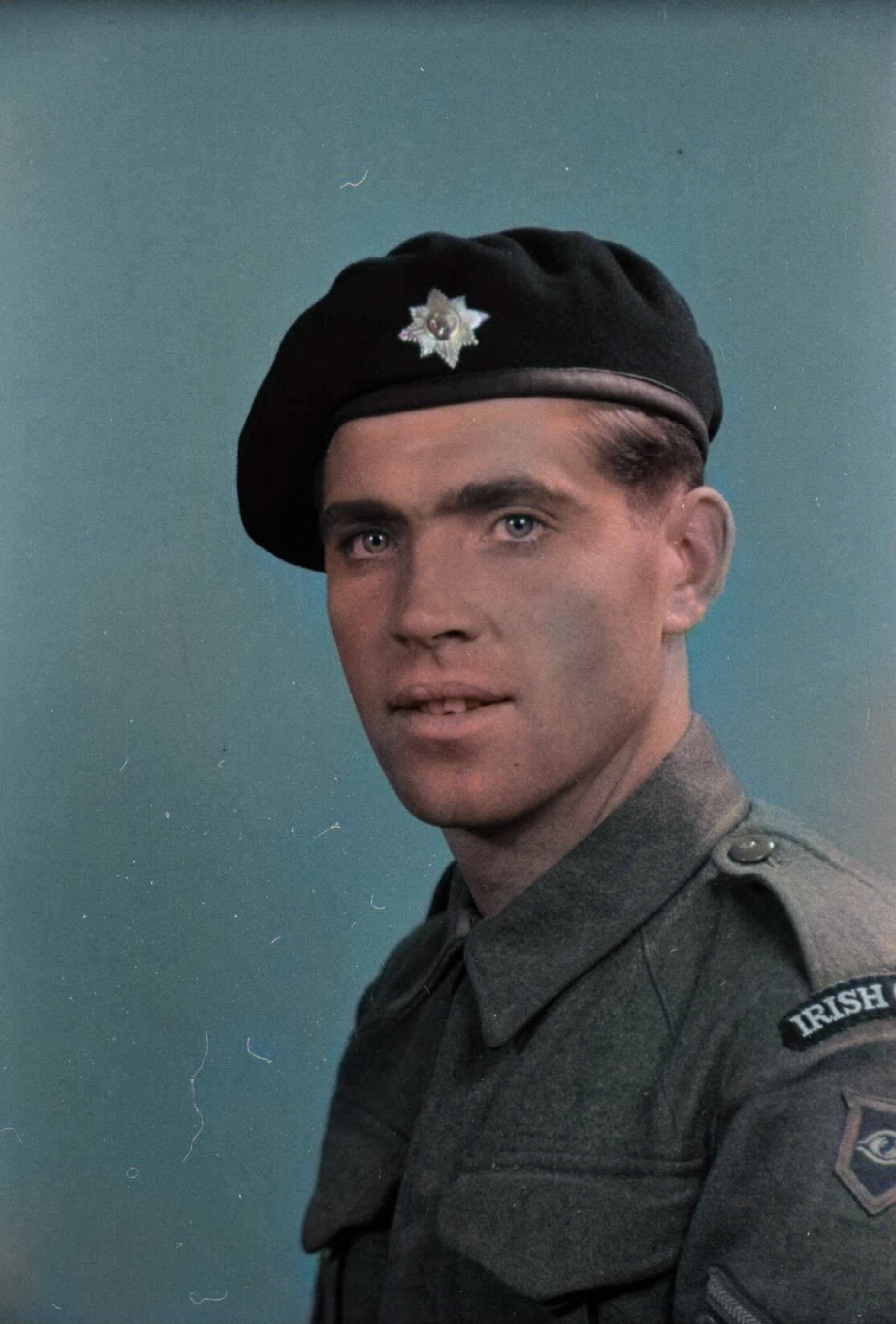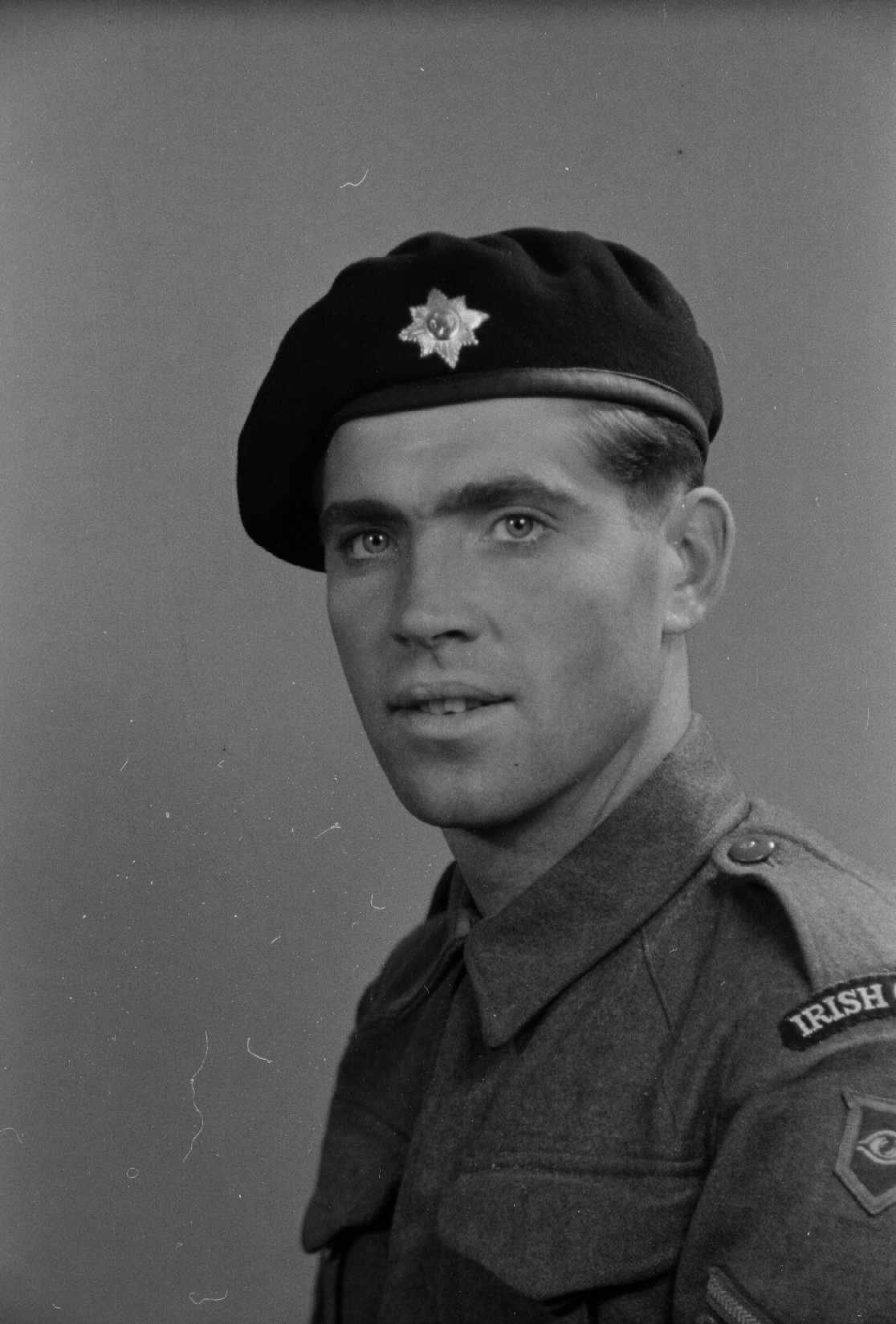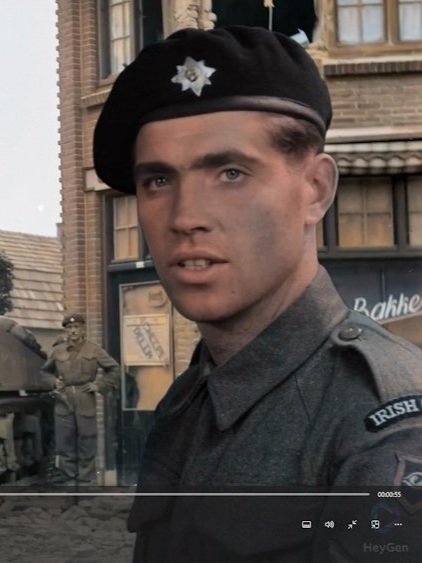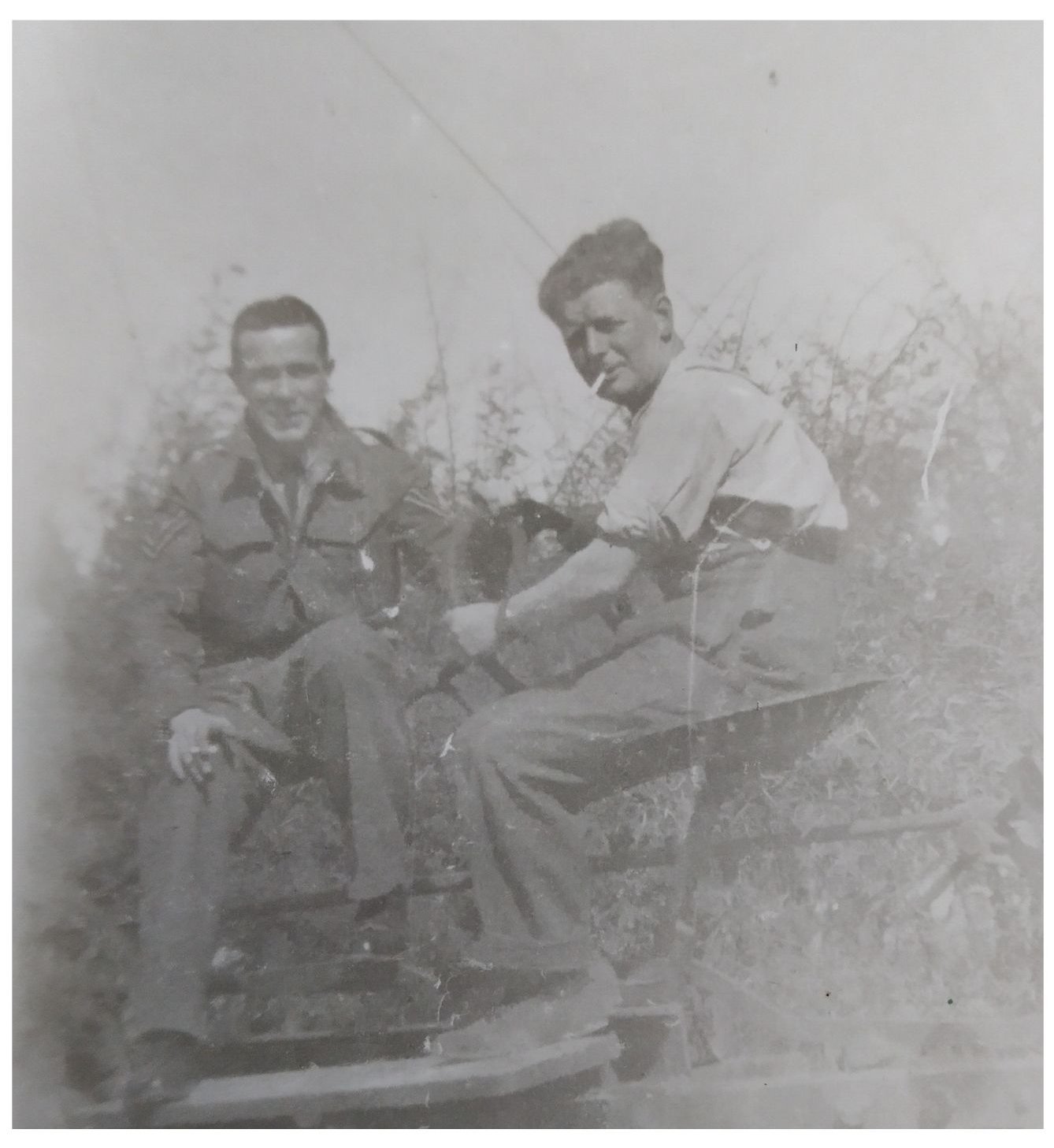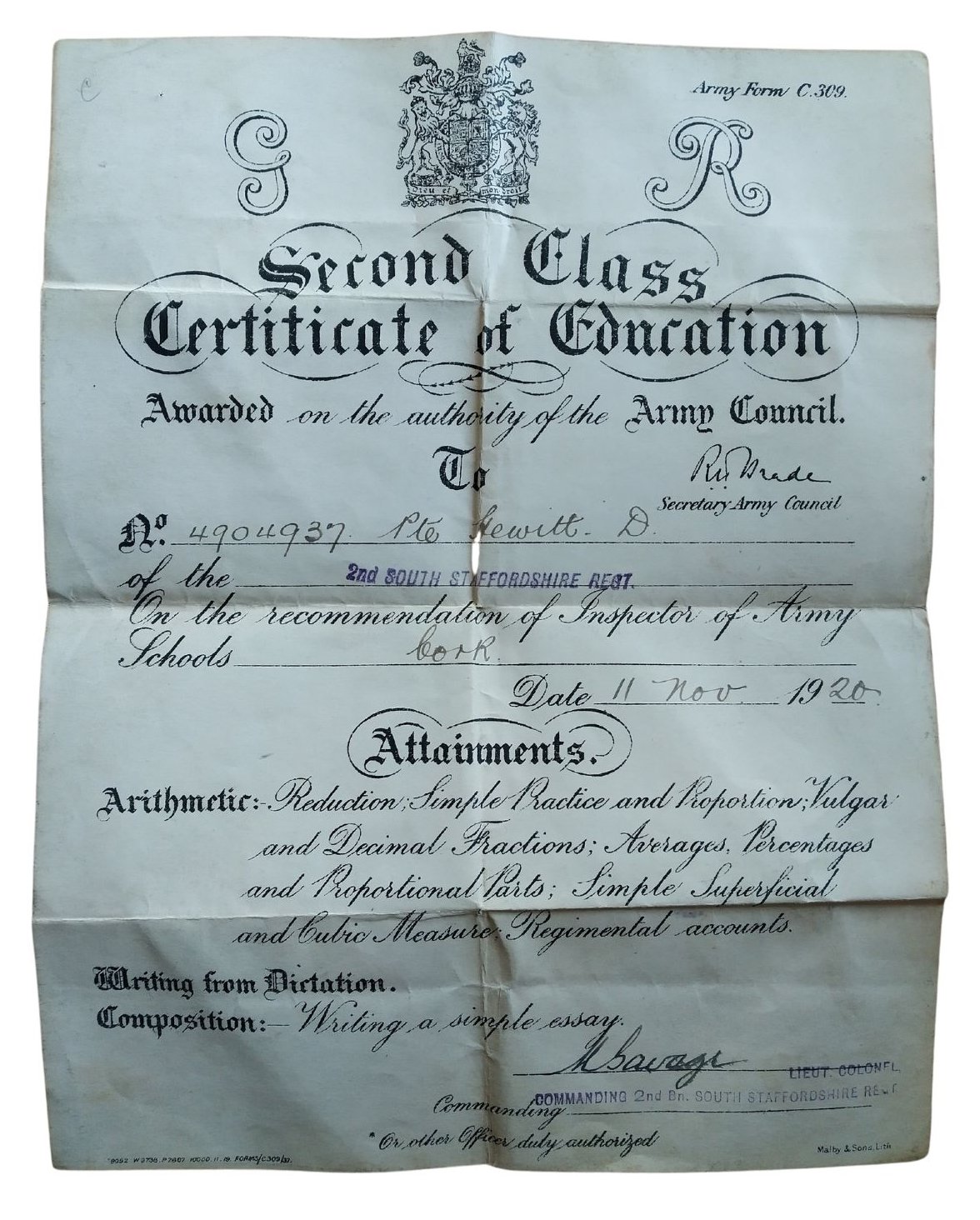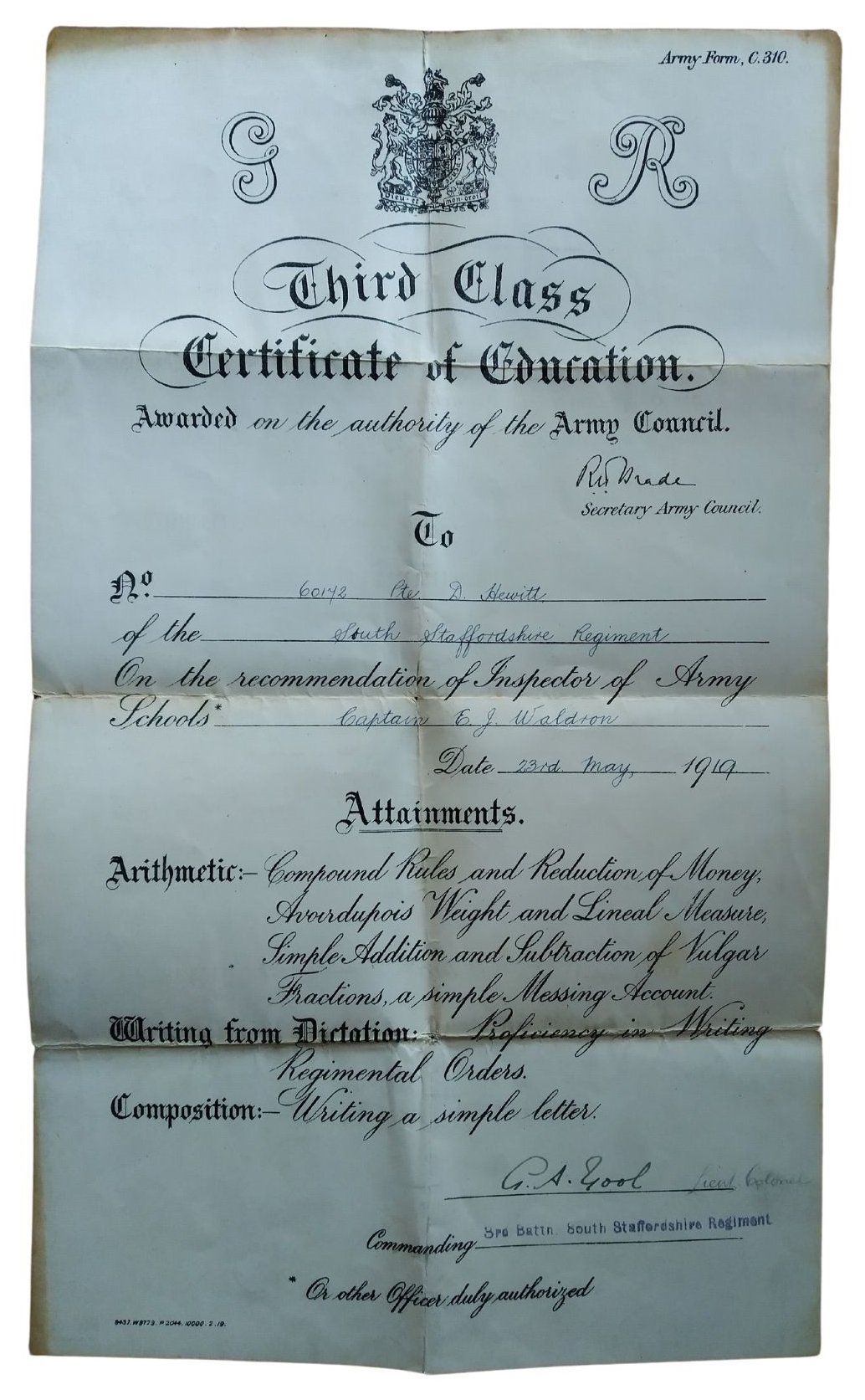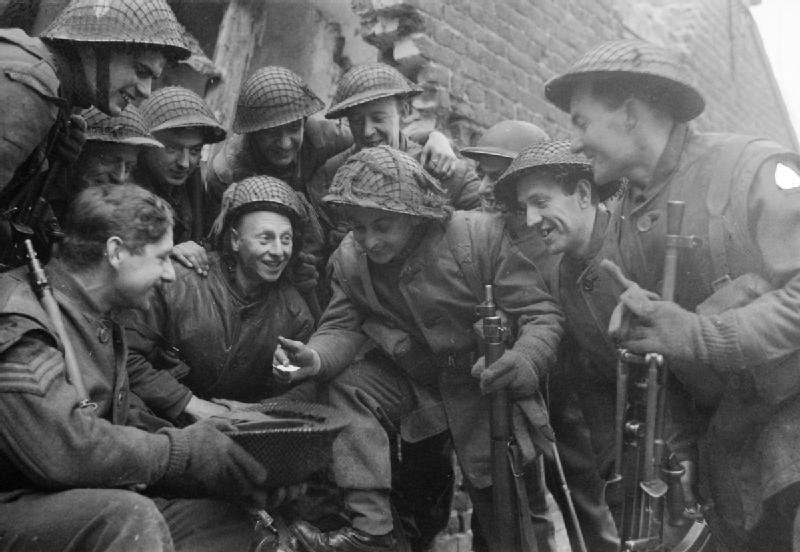
The Second World War resulted in the deaths of around 85 million people. Additionally, tens of millions more people were displaced. However, amid all the carnage people demonstrated remarkable courage, fortitude, compassion, mercy and sacrifice. We would like to honour and celebrate all of those people. In the War Years Blog, we examine the extraordinary experiences of individual service personnel. We also review military history books, events, and museums. And we look at the history of unique World War Two artefacts, medals, and anything else of interest.
How AI Can Help You Discover and Celebrate Your Military Ancestors
In this blog post, we will explore how AI can help you discover more about your military ancestors in two ways. First, AI can assist you in conducting historical research. Second, AI can now help to transform old black-and-white family photos into moving colour video footage, enabling your ancestors to tell their own stories.
If you are interested in your family history (genealogy), you may have wondered if any of your ancestors served in the military. Military service is a common and significant part of many people’s heritage, and learning more about it can enrich your understanding of your family’s past. However, finding and accessing military records can be challenging, especially if you don’t know where to look or how to interpret them. Moreover, even if you manage to find some information about your ancestor’s military service, you might still feel a gap between you and them, as you only have some names, dates, and facts, but no sense of who they were as individuals, what they looked like, what they sounded like, and how they lived. This is where AI can help.
AI, or artificial intelligence, is the ability of machines to perform tasks that normally require human intelligence, such as learning, reasoning, and problem-solving. AI has been advancing rapidly in recent years, thanks to the availability of large amounts of data and powerful computing resources. AI has many applications in various fields, including military history research and presentation.
In this blog post, we will explore how AI can help you discover more about your military ancestors in two ways. First, AI can assist you in conducting historical research. Second, AI can now help to transform old black-and-white family photos into moving colour video footage, enabling your ancestors to tell their own stories.
How AI Can Help You Conduct Historical Research
One of the main challenges of military history research is finding and accessing relevant sources. Military records are often scattered across different archives, libraries, museums, and online databases, some of which may be inaccessible or incomplete. Moreover, military records can be difficult to read and understand, as they may use unfamiliar terminology, abbreviations, symbols, or handwriting. Furthermore, military records may not provide enough information about your ancestors’ personal lives, such as their motivations, emotions, opinions, or relationships. AI can help you overcome some of these challenges by providing you with tools that can search, analyse, and synthesize large amounts of data from various sources.
For example, AI can help you:
Find and access military records that match your criteria, such as name, date of birth, place of origin, rank, unit, service number, etc.
Extract and organise relevant information from military records, such as dates, locations, events, awards, casualties, etc.
Translate and explain military terminology, abbreviations, symbols, or handwriting that may be unfamiliar or unclear to you.
Cross-reference and verify information from different sources to ensure accuracy and completeness.
Fill in the gaps or resolve the contradictions in the available information by using historical context and logic.
Generate summaries and reports of your findings that highlight the key points and provide additional details.
By using AI tools for historical research, you can save time and effort that you would otherwise spend on searching for sources manually. You can also gain a deeper and broader understanding of your ancestors’ military service by accessing more information from more sources. You can also learn more about the historical background and significance of your ancestors’ service by getting explanations and interpretations from experts. However, many archives have yet to fully digitise their collections. As a result, having to do some manual research is almost inevitable when conducting military history research.
How AI Can Help You Celebrate Your Military Ancestors
Military history research can be a fascinating journey, but it’s not always easy to share your findings in a way that is engaging and meaningful. Military records may provide some facts about your ancestors’ service, but they may not capture their personality or character. Old family photographs may give you a glimpse of what your ancestors looked like but do not convey their voice or tone. Wouldn’t it be amazing if you could see your ancestors in colour and hear them speak for themselves?
Visit our Virtual Ancestor webpage now to learn more.
Virtual Ancestor
At The War Years, we offer a new service called the Virtual Ancestor. Using the latest AI tools, we can transform a few old fading photographs into vibrant colour videos of your ancestors. Your ancestors will be able to tell their own story in the first person, based on our research of their military service. You will be able to see and hear your ancestor and learn more about their military service, their achievements, their challenges, and their personalities.
With Virtual Ancestor, you can celebrate your military ancestors in a unique and engaging way. It’s a great way to connect with your family history and learn more about your ancestors’ lives.
Contact us today, to learn more about our Virtual Ancestor and similar AI-generated historical content.
Dick Hewitt and the Desert Air Force
Dick Hewitt served as an Armourer with a mobile fighter squadron as part of the Desert Air Force (DAF) from 1943 to 1945. During Dick’s time in the RAF, he kept a diary, although this was against regulations. Although the diaries are incomplete, they have provided enough clues and information to be able to retell the wartime story of one Leading Aircraftman and his role in the Allied campaign for Italy.
Dick Hewitt served as an Armourer with a mobile fighter squadron as part of the Desert Air Force (DAF) from 1943 to 1945. During Dick’s time in the RAF, he kept a diary, although this was against regulations. Although the diaries are incomplete, they have provided enough clues and information to be able to retell the wartime story of one Leading Aircraftman and his role in the Allied campaign for Italy.
Dick Hewitt was born on Thursday 18 April 1901 in Leicester. Dick passed away on Friday 7 June 1985, aged 84, in Birmingham.
Service in the British Army
Amongst Dick’s personal papers, I found several Certificates of Education awarded to Private D. Hewitt, the 2nd Battalion, South Staffordshire Regiment issued in May 1919 and November 1920, which suggests that Dick was conscripted into the Army (as conscription did not end until mid-1919). The 2nd Battalion spent the immediate post-war years in Ireland during the War of Independence (1919-21). One of Dick’s Certificates of Education was issued from Cork, which confirms that he was stationed in Ireland. The Corps of Army Schoolmasters was replaced in 1920 by the Army Educational Corps (AEC). A brief search of The National Archives and British Army World War I Service Records, 1914-1920, found no record of Dick’s early military service with the South Staffordshire Regiment.
Dick was in his early to mid-forties during the Second World War. Most of his comrades would have been in their late teens to mid-twenties. Perhaps unsurprisingly, as an older man, it appears Dick’s comrades referred to him as ‘Pops’ based on some post-war correspondence found amongst Dick’s personal papers. Dick was married with two children while serving in the RAF and he sent money home to his family whenever he was able.
Service in the Royal Air Force
Dick’s RAF Service No: 1468728. He held the rank of Leading Aircraftman (LAC) and qualified as an Armourer. Dick served with 324 Wing, No. 93 Squadron, Royal Air Force, part of the BNAF (British North Africa Force). As part of a highly mobile fighter squadron originally equipped with Spitfire Mk. Vs and later Mk. IXs, Dick served in North Africa, Malta, Italy, Corsica, and southern France.
The Role of the Armourer
As an Armourer with No. 93 Squadron, Dick’s role was to arm the Spitfires of No. 93 Squadron with ammunition and bombs, regularly strip and clean the guns and perform general maintenance. Based on Dick’s diary entries, he also worked on fitting supplementary fuel tanks to the Spitfires, which extended their range.
Diary Entries: UK Training & Posting Overseas 1942
9 January: Left Halton Camp for Kirkham. RAF Halton, near Wendover, Buckinghamshire, was a major RAF training centre. Similarly, RAF Kirkham, Lancashire, was the main armament training centre for the RAF from November 1941.
1942: Passed Armourer’s course, A.C. II. – Aircraftman 2nd class.
30 March 1942: Passed L.A.C. exam – Leading Aircraftsman.
1942: Arrived at RAF Speke. Note: Today, RAF Speke is Liverpool John Lennon Airport.
1942: Promoted A.C. I. - Aircraftman 1st class.
11 November: Left Wareford for overseas. By train to Scotland. Arrived at Greenock at 08.00hrs.
13 November: Boarded the HMT (His Majesty's Transport) Bergensfjord (a former Norwegian ocean liner). Navy, Army, and Air Force personnel were all on board.
14 November: Left Greenock at 05.00hrs heading for the North Atlantic. There are 16 boats in our convoy escorted by Royal Navy Destroyers.
20 November: Nearing the Mediterranean, passed Gib (Gibraltar) at midnight. Could see Tangiers lit up at night.
Tunisia 1942
8 December: Arrived at Souk-El-Arba station (Tunisia) at 08.00hrs. We’re about 40 miles behind the frontline.
19 December: Had a terrible sight to witness as one of the (ditto) ground crews was taken up in the air sitting on the tail of a plane. The kite (RAF slang for aircraft) crashed on landing throwing the man right over the front of the kite. He sustained serious injuries to his legs. Note: During bad or windy weather, it was common practice to have a member of the groundcrew sit on the tailplane of an aircraft as it taxied to its take-off position. Usually, the groundcrew would dismount while the pilot carried out their pre-flight checks.
30 December: Nearly killed when strafed by a Jerry aircraft. Had to dive for cover on the roadside. Learned all the Squadron’s tools were lost when the boat carrying them was torpedoed on 18 December.
The Desert Air Force (DAF) in Tunisia
The Allied campaign in Tunisia started in November 1942. By late March and throughout April 1943, the Desert Air Force (DAF) was conducting bombing and strafing missions (interdiction) on infrastructure, such as bridges, supply routes, Luftwaffe airbases, Tunisian ports, and the capital of Tunis. They also flew missions over Sicily and southern Italy. The aim of the missions was twofold. First, starve Axis forces of everything from fuel and ammunition to food, and thus weaken their ability to resist. The second was to establish Allied air superiority over the battle space and enable the ground forces to make a final push on the Tunisian capital. The DAF also provided close air support to Allied ground forces.
On 7 May 1943, Allied armour rolled into Tunis, taking many Axis troops based in the city completely by surprise. By 10 May, the Luftwaffe had evacuated what aircraft and equipment they could salvage. The capture of Tunis led to an Axis surrender and the capture of around 250,000 prisoners. It was a significant Allied victory.
No 72 Squadron, 324 Wing RAF. Spitfire, North Africa 1943.
Diary Entries: Tunisia 1943
3 February 1943: Jerry bombed drome (aerodrome) in the morning. Three RAF were killed and five wounded. Bombs were released from FWs (Focke Wulf 190 fighter-bombers) while I was having a wash. Eight Spits U.S. (unserviceable).
22 February 1943: Fortresses (B.17 Flying Fortress heavy bomber) dropped bombs on Souk-El-Arba, 25 people killed by mistake. Note: There were two airfields at Souk-El-Arba both located near what was at the time the village of Souk-El-Arba but since 1966 has been known as Jendouba. The site is about 81 miles west-southwest of Tunis.
1 March 1943: Kites on a bomber escort, one Spit and one ME (presumably a Messerschmitt Bf 109) shot down during a dogfight over the drome at 12.30hrs.
2 March 1943: Air Marshal Sir Arthur Coningham arrived at the drome. Note: Today, Coningham is chiefly remembered as the person most responsible for the development of forward air control parties directing close air support, which he developed as commander of the Western Desert Air Force between 1941 and 1943.
16 March 1943: Dive-bombed without warning. Dived under a kite and watched bombs bursting. AA (anti-aircraft artillery) returned fire. One soldier was killed.
April 1943: Squadron mainly assigned to bomber escort missions. Note: The Allies heavily bombed Axis (Luftwaffe and Italian) airfields and infrastructure such as bridges. Enemy air activity diminished as the Allies' bombing campaign intensified.
7 May: Tunis reported taken.
10 May: Bizerta reported taken. After being reported missing Red Herbert got back to the airfield with 20 released prisoners.
12 May: Thousands of prisoners taken. End of the campaign in Africa.
14 May: Move to a new drome between Tunis and Bizerta. Met thousands of prisoners and passed through the battlefront. Saw plenty of wrecked tanks, etc.
15 May: On new drome. Found a camp bed, very useful. Bags of rifles, etc. Crashed and wrecked Ju-52s all over the airfield and two ME-109s. Had to be careful of boobytraps and mines. Note: The Junkers Ju-52 is a three-engine transport aircraft and was a mainstay of the German Air Force (Luftwaffe).
20 May: Victory Parade at Tunis. Thousands of troops were in the town.
24 May: Went souvenir hunting. Found the famous Ace of Spades Squadron drome. Every kite was either burned out or shot up. Bags of stores lying about. In this diary entry, Dick is referring to the Jagdgeschwader 53 (JG 53) fighter-wing of the Luftwaffe, known as the "Pik As" (Ace of Spades).
26 May: Move to a drome at Mateur, which is situated between Bizerta and Tunis.
8 June: Drove to Sfax harbour (south of Tunis) and boarded a Landing Ship, Tank (LST).
9 June: Arrived in Malta.
Dick Hewitt, on the left, sitting on the wing of a Spitfire. Date and location of photograph unknown.
Malta 1943
20 June: The King arrived in Malta. He visited the drome.
24 June: Sir Archibald Sinclair (Secretary of State for Air) visited the drome in the afternoon and gave a speech. He thanked us for our work in North Africa.
10 July: Operation HUSKY. Sicily was invaded by troops at 02.30hrs. Kites on dawn sweeps (sorties) over Sicily. Worked until 23.00hrs.
Operation HUSKY, Allied Invasion of Sicily, 9 July - 17 August 1943
Prior to an Allied invasion of the Italian mainland, it was necessary to capture the island of Sicily. Axis forces based on Sicily were resupplied across the Messina Strait. The key target of the invasion was the port of Messina, the link to the Italian mainland. But it was heavily defended and its distance from North Africa meant the Allies could not attack it directly.
A major concern and threat to the invasion fleet was the Italian island of Pantelleria, about 50 miles from the Tunisian coast and halfway to Sicily. The island could be used by Axis forces to attack the invasion fleet at sea. Consequently, the island was heavily bombed and then shelled by the navy. Finally, on 11 June 1943, British troops landed at the main harbour, and the island garrison surrendered.
During June and July 1943, the Desert Air Force started to relocate to Malta in preparation for the invasion of Sicily.
On 9 July, British, Commonwealth and American troops started landing on Sicily preceded by airborne forces. In the weeks prior to the invasion, the Allies had launched a concerted aerial bombardment of the Axis air forces on Sicily – winning air superiority. However, bad weather on the night of 9 July resulted in the airborne forces being scattered. Once ashore, the British 8th Army initially made steady progress north until checked at Catania. The Americans, under General Patton, took Palermo. After fighting a defensive campaign for about two weeks, the Axis forces started to withdraw. After 38 days, Allied forces finally took Messina. However, around 120,000 enemy troops had been successfully evacuated. At the time, Operation HUSKY was the largest amphibious invasion of the Second World War with over 180,000 men, 4,000 aircraft, and 3,000 vessels deployed.1
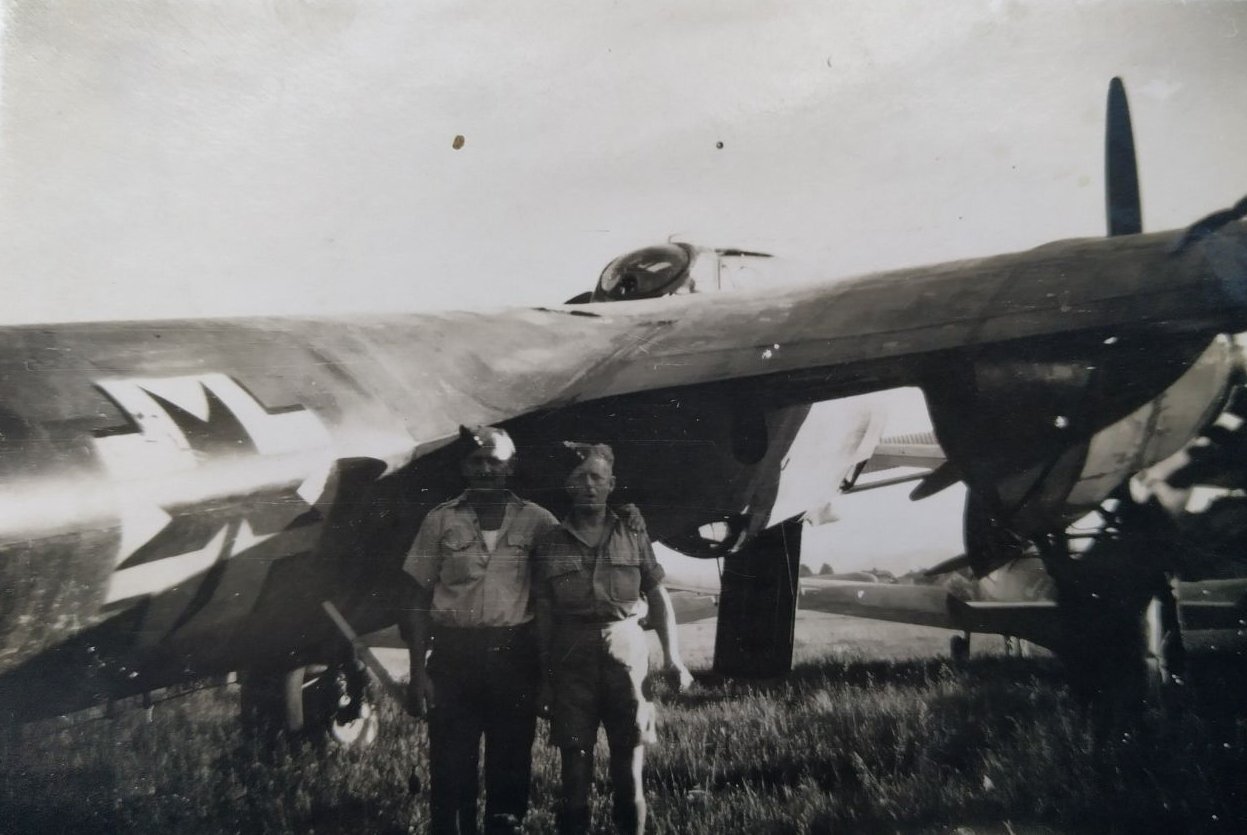
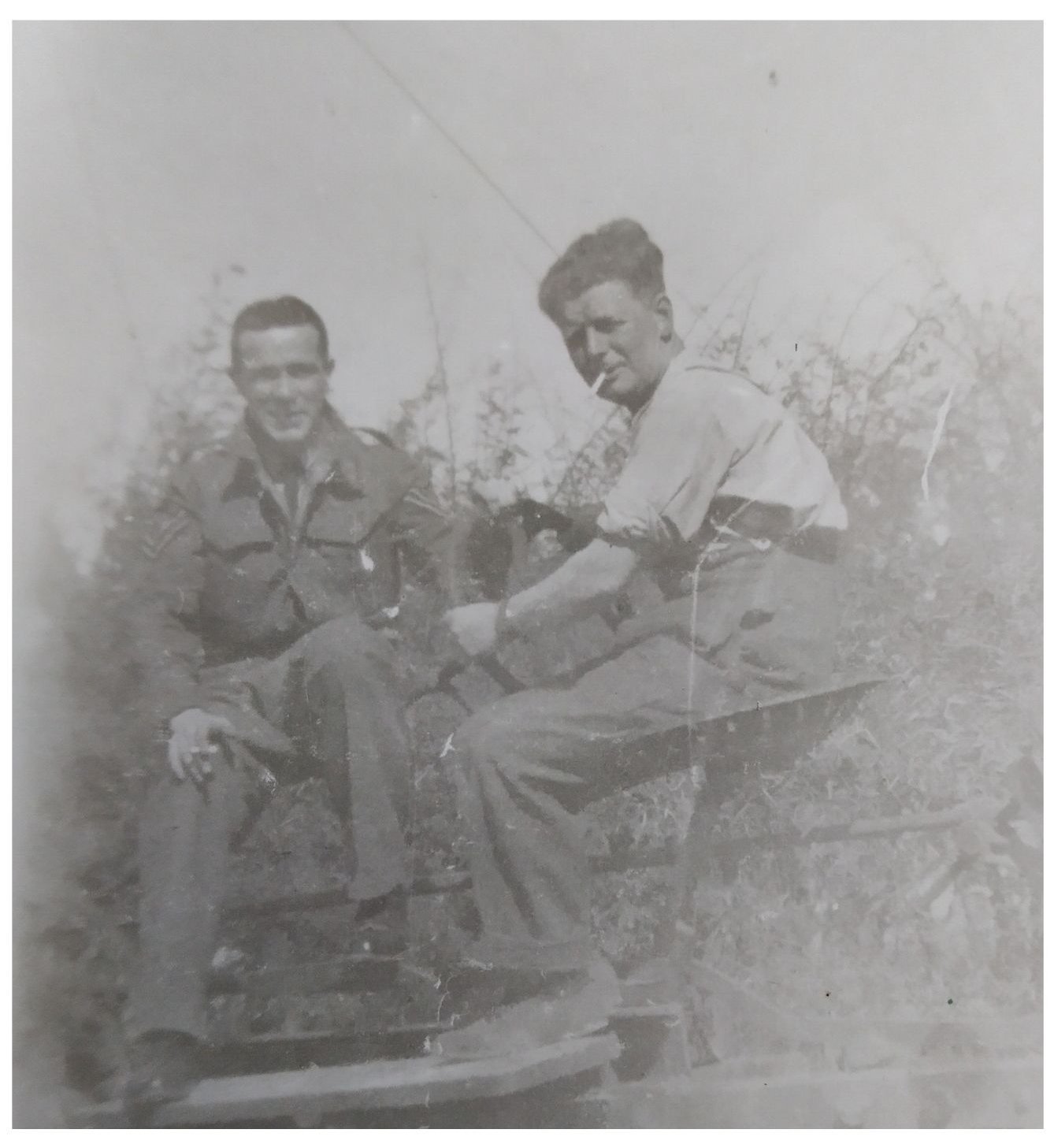
Italy 1943
19 – 20 July: Moved by tank landing craft to Sicily. Arrived Pachino beach (southern tip of Sicily) at 06.00hrs.
12 August: Jerry bombed Lentini Drome (south of Catania) during the night (surprise raid) 24 kites were written off, and 96 airmen were killed or wounded (322 Wing).
13 August: Jerry retreats toward Messina evacuating troops.
17 August: Messina reported taken.
18 August: End of Sicilian Campaign.
27 August: Moved to Gerbibi near Mount Etna (west of Catania).
7 September: Arrived Falcone (north coast of Sicily).
Operation AVALANCHE – Allied landings at Salerno, 8/9 September 1943
German forces correctly anticipated the Allied landings near the port of Salerno by the U.S. 5th Army and concentrated five divisions against the beachhead. Initially, it appeared the Allies might be thrown back into the sea. However, Allied airpower gradually strangled the Germans' ability to resupply its land forces, and gradually they had to give ground. However, the Germans exploited the mountainous terrain to their full advantage as they staged a fighting withdrawal northward. Eventually, Allied progress was brought to a halt along the heavily fortified ‘Gustav Line’.
8 September: We were told landings would be made near Naples during the night (Operation AVALANCHE). Ready to move to Naples. Italy surrendered and Naples invaded in the early hours.
During the next few days, the Squadron flew numerous sorties over the beachhead providing air support to the ground forces.
23 September: Moved to Milazzio (west of Messina) and boarded transport, moved off at 20.30hrs headed for the Italian mainland.
24 September: Convoy shelled. Landed midday near Salerno.
28 September: Moved to Battipaglia drome (east of Salerno).
11 October: Moved to Naples passing through Pompei.
30 October: Air Chief Marshal Sir Keith Park landed at Drome. Note: Park played a pivotal role in winning the Battle of Britain.
Usually, a Spitfire Squadron had twelve aircraft split into two flights of six (A and B Flights). In combat, the aircraft would typically divide into smaller groups of two or three aircraft.
12 November: German fighter bombers attacked a nearby airfield. The Squadron’s aircraft were scrambled and pursued the enemy aircraft, but they escaped.
14 November: 324 Wing broke the record for the number of kites shot down in 12 months: 301.5.
22 November: Enemy aircraft strafed the main road to Rome. Six enemy aircraft were shot down and another six were probably downed.
24 November: Six aircraft on shipping patrol and ‘L’ on patrol of the front line (presume that the letter ‘L’ refers to an individual aircraft).
26 November: A German Ju-88 (The Junkers Ju-88 twin-engine multirole combat aircraft) was shot down by 435 Squadron. Kites on mine sweeping patrol. Enemy aircraft over our drome and heavy AA fire (anti-aircraft artillery sometimes referred to by the British and Commonwealth forces as Ack-Ack).
28 November: Strafed road transport – four trucks and two staff cars hit. F/O (Flying Officer - a junior commissioned rank in the Royal Air Force) Swain dived too low, hit some trees, and then went straight into the ground.
2 December: Kites on bomb line patrol. Note: The bomb line is a line or limit beyond which aircraft may make attacks on the enemy without risking damage to their own troops.
5 December: Kit bags lost at BARI (Bari is a port city on the Adriatic Sea and the capital of southern Italy’s Puglia region). 12 ships sunk in the harbour. Souvenirs, etc. all lost, and 500 Woodbines (British brand of cigarettes).
7 December: Red Herbert shot down a Me-109, his first kill. Note: The Messerschmitt Bf 109 was the backbone of the Luftwaffe’s fighter force along with the Focke-Wulf Fw-190. Me-109 and Bf-109 are used interchangeably to refer to the aircraft.
10 December: Jet tanks fitted. Note: I am assuming this diary entry refers to the ground crew fitting jettisonable extra fuel tanks to the Spitfires. These fuel tanks extended the range a Spitfire could fly but also somewhat limited the aircraft’s performance. The fuel tanks were fitted under the central section of the fuselage and carried a 30, 45 or 90-gallon capacity. They were also known as drop tanks or ‘slipper’ tanks and could be jettisoned after use or before engaging enemy aircraft.
16 December: FLT (Flight Lieutenant) Taylor was shot down and belly-landed on a beach. Returned safely the next day.
Christmas: Dick seems to have enjoyed the Christmas period with plenty to eat and drink. He complained of feeling hungover on Christmas day after too much merry-making the night before.
The weather during the late autumn and early winter of 1943/44 steadily deteriorated. The Squadron was often at half-hour readiness (held ready to scramble into action if required). When not working, Dick appears to have spent much of his free time visiting local towns, going to the cinema and the occasional concert, and following the inter-squadron football matches. He was also assigned to sentry duty.
Italy 1944
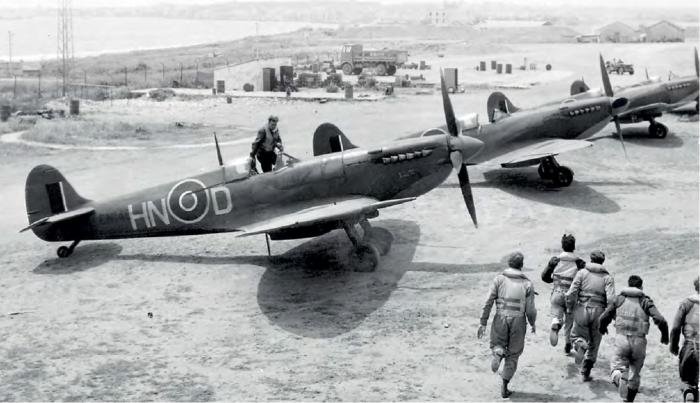
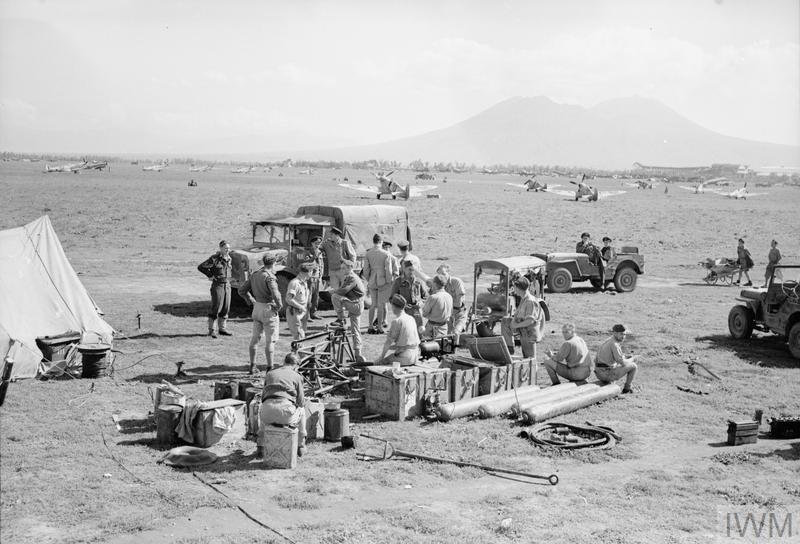

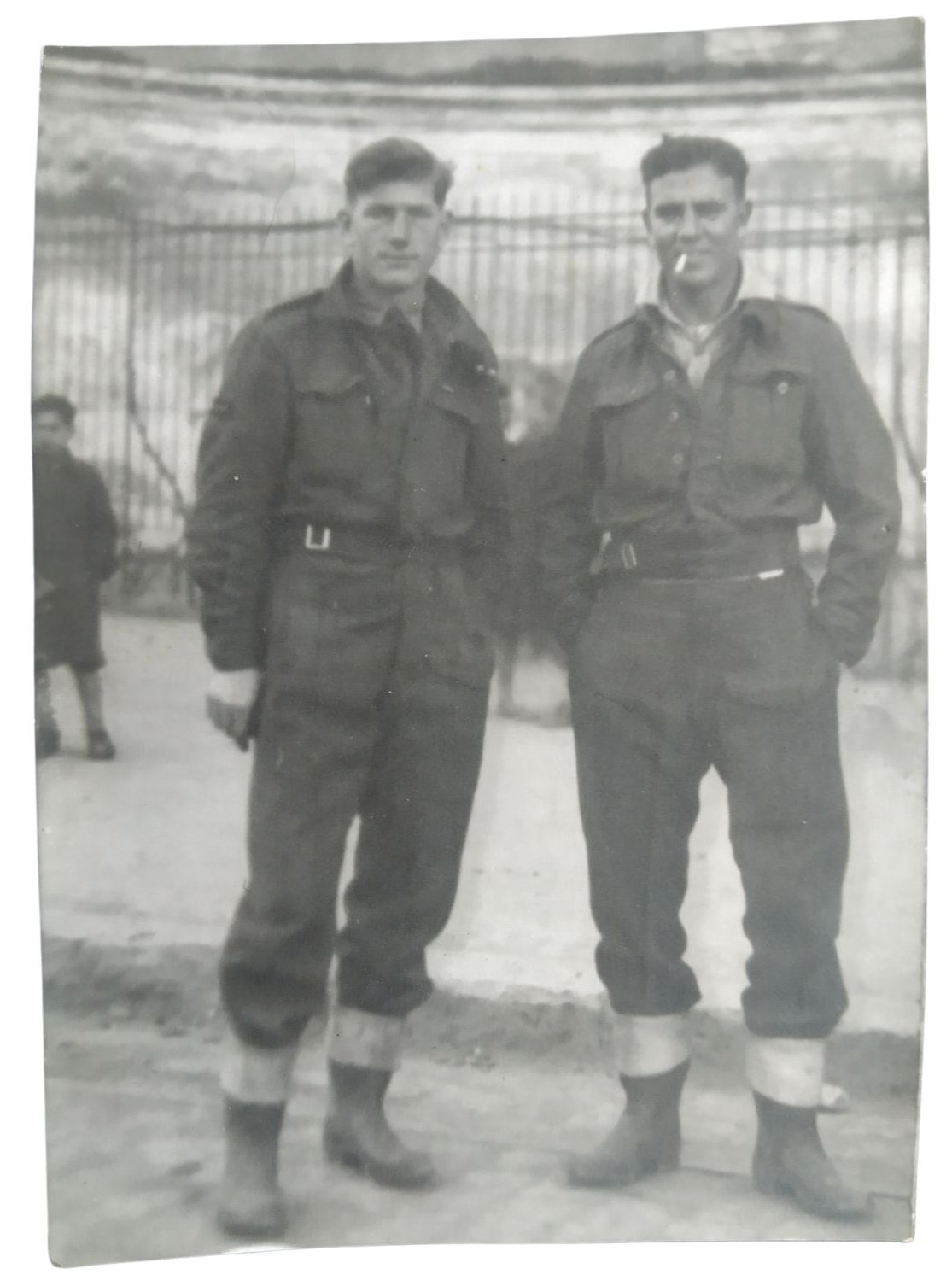
11 January: Typhus is very bad in Naples.
13 January: Bombers over all day (Flying Fortresses) about 950 passed overhead on their way to bomb Cassino (Between 17 January and 18 May, Monte Cassino and the Gustav Line defences were attacked on four occasions by Allied troops.). All fives went away replaced by nines. Note: Dick is referring to the replacement of Mk. V Spitfires with the new Mk. IX variant.
14-16 January: Prepared to move to a new location. Left Naples at 10.30hrs and arrived at the new drome about 14.00hrs. Crossed the Volturno River Bridge.
18 January: Watched Bostons drop their loads on enemy positions and return safely. In this diary entry, Dick is referring to the American-built Douglas A-20 Havoc medium bomber that was renamed the Boston by the RAF.
19 January: 15 miles behind front lines – guns firing.
Operation SHINGLE, the Battle of Anzio, 22 January – 5 June 1944
To break the deadlock and get the Allied advance moving again, the High Command decided to launch another amphibious landing. The intention of Operation SHINGLE was to bypass the Gustav Line, forcing the Germans to pull troops back from Cassino and open the road to Rome. Operation SHINGLE was launched on 22 January 1944. Initially, the landings were unopposed. However, the Allies quickly lost the initiative and failed to break out from the beachhead. Instead, by 25 January, the Germans counterattacked with elements of five divisions and quickly surrounded the Allied landing force. For months, the Anzio campaign dragged on with neither side able to gain a significant advantage. Eventually, the deadlock was broken when the Allies launched a series of new operations compelling the Germans to redeploy their limited forces. On 4/5 June, Rome fell, but the Germans remained undefeated and pulled back to a new defensive position known as the Gothic Line.2
21 January: Told that another landing would be made 50 miles north of here during the night at Cape ANZIO.
22 January: Landings successful – no opposition. Went to the village of Mondragone (situated on the coast about 28 miles northwest of Naples). The village had been badly bombed.
27 January: The Squadron fetched four down and two damaged for the loss of one pilot missing. Dick often uses the term ‘fetched down’ in his diaries to indicate that the Squadron had either shot down or damaged enemy aircraft.
28 January: The Squadron is down to six serviceable aircraft due to prangs. Plenty of shelling night and day. Note: The loss of aircraft due to non-operational accidents seemed common at the time. Between 1939 and 1945 RAF Bomber Command, for example, lost 1,380 aircraft within the UK on operational flights and 3,986 aircraft in non-operational accidents.
7 February: Two MEs (Messerschmitt Bf 109s) shot down. Red Herbert forced landing with serious injuries.
10 February: Cruisers shelling enemy positions night and day.
12 February: Jerry active over ANZIO beach, bombing and strafing.
15 February: Red Herbert died in hospital. Note: In fact, Flight Sergeant Henry Ivor (Red) Herbert, Service Number: 415189, 93 Sqdn., Royal New Zealand Air Force, died on 7 February 1944, age 20. Red is buried at the Anzio War Cemetery. He had been flying Spitfire Mk. IX MA509.
16-17 February: Dick says the Wing shot down seven enemy aircraft over the ANZIO beachhead. He also writes that ‘R’ and ‘Z’ both had forced landings at ANZIO. I am assuming that Dick is referring to individual aircraft using the RAF letter code. The RAF used three-letter codes to identify aircraft from a distance. Two letters before the roundel, for the squadron to which the aircraft belonged, and another letter after the roundel for the individual aircraft.
1 March: Record of enemy kites destroyed 343.5.
16 March: Cassino was heavily bombed for two days.
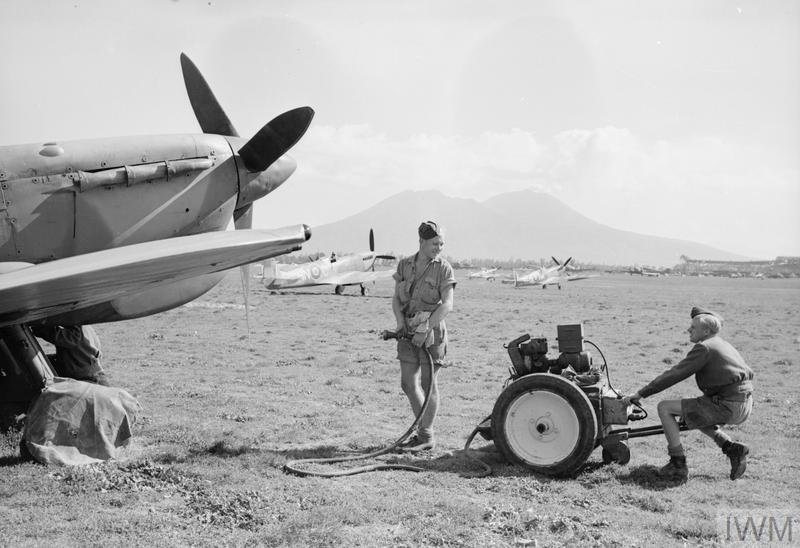
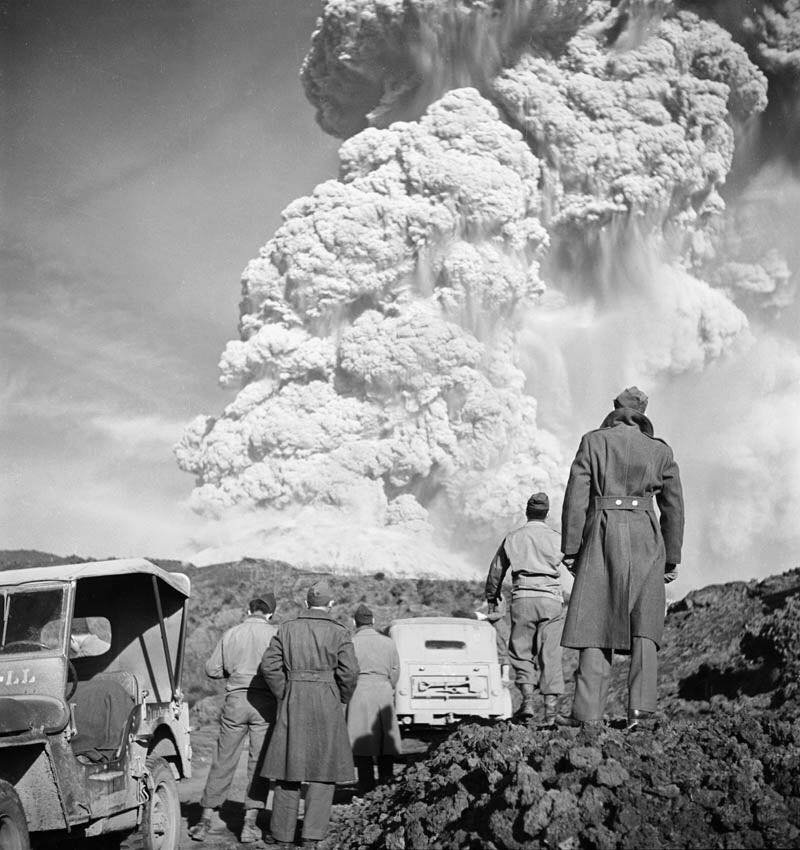
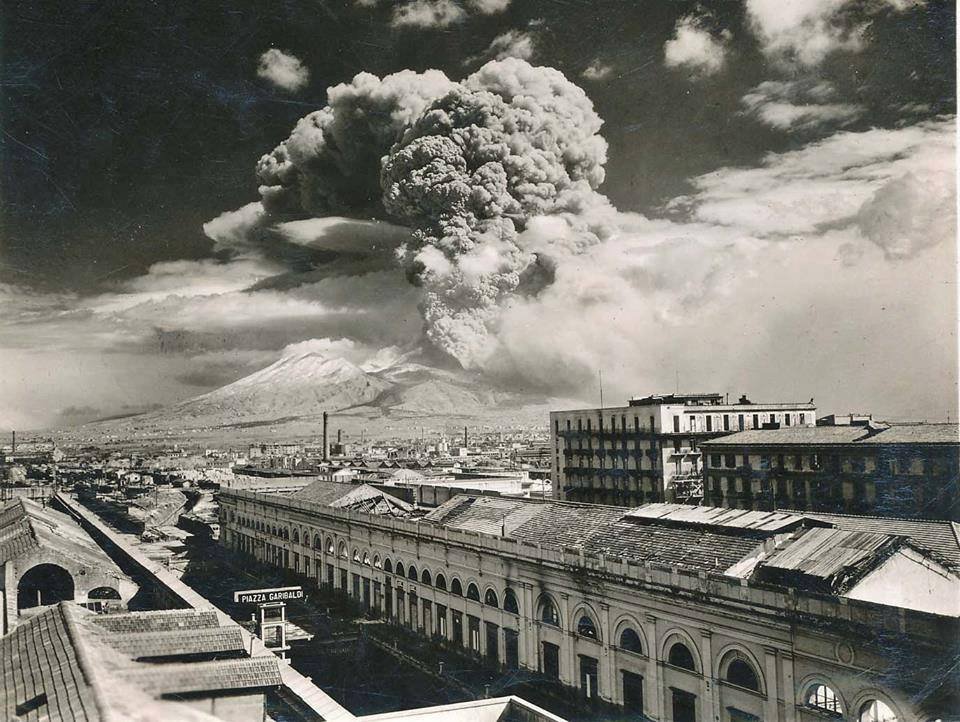
18 March: Went on a day trip to Napoli (Naples). Returning at night saw Mount Vesuvius in eruption. Most wonderful sight to see. Hot lava running down the sides. Still visible at 30 miles. The volcanic eruption had started the day before and lasted for about ten days.
22 March: Mount Vesuvius – People have started to evacuate southern Naples.
23 March: Finished work at 17.00hrs and went on a trip to see Mount Vesuvius at night. A sight worth seeing.
24 March: W/O (Warrant Officer) Bunting fetched two MEs down and then force-landed at ANZIO. He returned to our drome flying a Kitty-Hawk. Note: The RAF continued to operate Kittyhawks in Italy until the summer of 1944 when they were finally replaced with North American Mustangs.
30 March: The Squadron's total: 52.5 enemy aircraft shot down, 18 probably shot down, 72.5 damaged.
Between April and mid-May 1944, the Squadron flew numerous sorties over the ANZIO beachhead. Enemy air activity appears to have tailed off with only occasional dogfights. However, pilots and aircraft were still lost, but more due to accidents than enemy action. Dick seems to have spent most of his time as a duty armourer. In his spare time, Dick visited Naples, went to the cinema and went swimming in the sea as the weather steadily improved.
19 May: Cassino and Monastery Hill taken. Plenty of bombers flying north during the day.
21 May: Squadron fetched eight Jerries down.
23 May: Offensive started at ANZIO. Squadron ready to move up.
3 June: ‘A’ Party packed lorries. ‘B’ Party took over Squadron kites. ‘A’ Party left camp at 19.00hrs for a drome 96 miles north.
6 June: Started to pitch camp. Heard that the Second Front has started. Rome taken. The liberation of Rome was completely overshadowed by the Normandy landings of D-Day (Operation OVERLORD).
7 June: 05.00hrs woken by anti-aircraft fire. Jerry over our drome.
8 June: Transferred to No. 8 C.C.S. (Casualty Clearing Station) six miles north of ANZIO to an airstrip called Tre Cancelli.
12 June: Packed trucks ready to move at night. Plenty of wrecked tanks on the road and bridges blown up.
13 June: 93 miles north of Rome arrived at Tarquinia (the town is situated on the coast, northwest of Rome) airfield at 03.00hrs. Passed through Rome at midnight. Wonderful buildings. Stayed about an hour in the city.
17 June: Dakotas landing all day to take away the wounded. Note: The Douglas C47 Dakota is one of the most successful military transport aircraft designs in history and was widely used by the Allies during World War Two.
22 June: Left No. 8 C.C.S. for Rome – had a tour of the city.
24 June: Moved about 60 miles north and arrived at Grosseto (another town close to the coast, northwest of Rome). The town was bomb-damaged. The R.E. (Royal Engineers) worked to repair the bomb-cratered landing strip.
4 July: Moved 50 miles north to a new airstrip. It appears from Dick’s diary that enemy air activity had dropped off considerably.
15 July: Moved about 110 miles, south to the docks.
17 July: Left harbour at 19.00hrs heading west, nine LSTs in convoy. Note: The LST or Landing Ship, Tank, was designed to carry around 18 Sherman tanks or 30 3-ton trucks and birth 200 troops. The ship could land vehicles, troops and cargo directly onto beaches without the need for a harbour.
18 July: Arrived Porto Vecchio, Corsica, at 11.00hrs. Headed north along the coast road, stopped overnight at Bastia (northern tip of Corsica).
19 July: Arrived at drome near Calvi (west of Bastia, on the coast) at 17.00hrs.
26 July: Went into Calvi in the evening and sold 200 cigarettes for 30/- (30 shillings) – a good price. You can sell almost anything here at a good price.
27 July: Getting ready for the invasion of southern France (Operation DRAGOON). 90-gallon (drop) tanks fitted to the aircraft. Pilots doing night flying and early mornings. Just the same as in Malta.
30 July – 2 August: Fighters sweep over Genoa and north.
3 August: 93 and 72 Squadrons do sweeps over Nice.
7 August: 43 Squadron pilot burned to death after belly landing and jet tank caught fire. A pilot from 225 Squadron drowned after nose-diving into Calvi Bay.
11 August: The whole Wing went on a strafing raid at 18.00hrs. They wrecked a lot of radio location stations around Nice. The mission was a complete success.
Operation DRAGOON, Invasion of southern France, 15 August – 14 September 1944
Operation DRAGOON (originally codenamed ANVIL) was an Allied invasion of southern France that led to the drive up the Rhone River Valley. Originally intended to support the D-Day invasion and Operation Overlord, DRAGOON was carried out more than two months later because of a lack of supplies and equipment. Within days, the Allies secured more than 40 miles of coastline and captured the vital French ports of Toulon and Marseille, providing critical support to the Normandy-based Allied forces moving to the German border. DRAGOON was largely an American and French operation, however, 324 Wing, including 93 Squadron provided part of the air umbrella.3
15 August: Invasion took place (start of Operation DRAGOON). Two gliders landed at the drome. A Fortress (Flying Fortress) landed shot-up by flak (A contraction of the German Flugabwehrkanone meaning anti-aircraft artillery). Kites doing air cover over the invasion beaches from dawn to dusk, but no Jerries to be seen.
21 August: Moved off for docks at 09.00hrs. Boarded LST at L'Île-Rousse (Corsica) and pulled out of the harbour at 20.00hrs. Very rough sea, the ship was rolling and pitching.
22 August: Arrived at Cavalaire (Cavalaire-sur-Mer is southwest of Nice between Saint-Tropez and Toulon in the southeast region of France) at 20.00hrs. Slept at a marshalling area outside of the town.
23 August: Left at 09.00hrs for a drome 15 miles away at St. Tropez and arrived at 11.30hrs. Departed again at 15.30hrs for a drome 140 miles north.
24 August. Terrible accident on the way down a mountain, and two died. Arrived at Cisteron (sic. Sisteron) at 20.00hrs. Marseille and Bordeaux regions of France were liberated by the Allies.
27 August – 1 September: The Squadron flew strafing sorties against enemy transport, shooting up trains, trucks, cars, etc. During this period several pilots and aircraft were lost.
5 September: Moved about 115 miles toward Lyon.
6 September: Left camp at 08.00hrs. Passed through Vienne (south of Lyon). We saw hundreds of Jerry transports burnt out along the road. Rhône valley. Arrived at Lyon airport at 16.00hrs.
8 September: The Squadron flew sweeps over Germany – strafed Jerry trucks. ‘M’ shot down in flames. F/SGT Wagstaffe killed. Flight Sergeant John William Wagstaffe, service No. 1430722, Royal Air Force Volunteer Reserve, 93 Squadron, was killed in action flying Spitfire Mk IX MH324. He is buried in Bessey-La-Cour Churchyard, France.
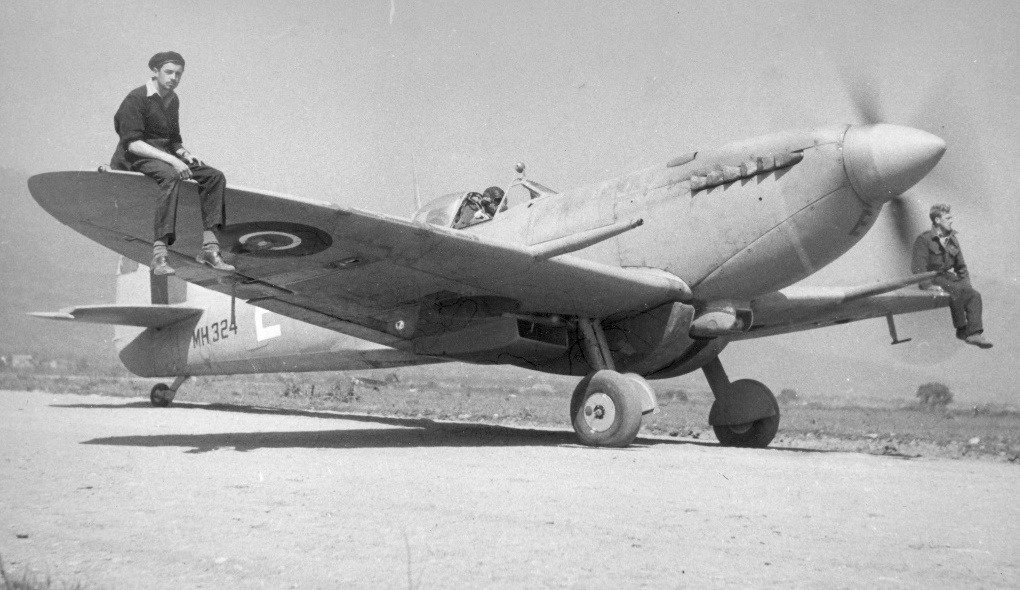
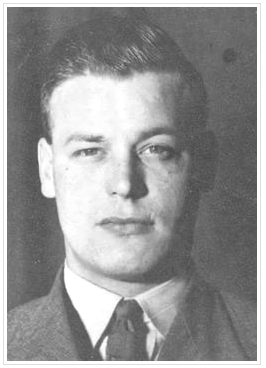
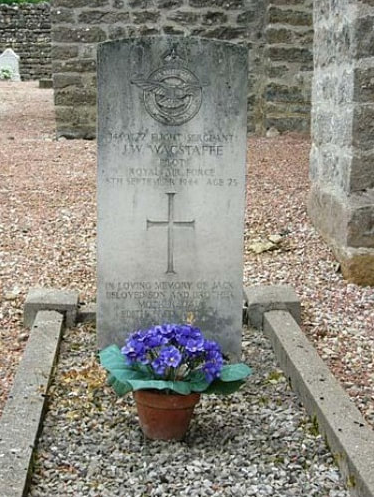
22 September: Moved back to Lyon, 150 miles.
28 September: Passed through Avignon, France, and arrived at La Jass (sic. La Jasse) at 15.00hrs. Travelled 160 miles.
3 October: Moved to Marseille. Arrived at the staging area at 16.00hrs.
5 October: Boarded LST at 05.00hrs.
6 October: The boat moved out at 11.30hrs in a heavy thunderstorm. The boat was like a rocking horse.
7 October: Passed between Corsica and Sardinia at noon. Turned north for Leghorn. Note: Livorno, Italy, also known as Leghorn, which derives from the Genoese name Ligorna.
8 October: Disembarked at 18.00hrs.
During October and November, the weather in Italy steadily worsened with the airstrips often flooded, making them unserviceable (US). As no sorties could be flown for days at a time, Dick spent his time watching films and doing sentry duty.
17 – 18 November: Travelled by lorry 112 miles to Via Figliano (north of Florence) and then another 120 miles to Rimini.
20 November: Fitting bombs on the aircraft. They successfully bombed a railway.
Italy 1945
For the remainder of November, December and into January 1945, No. 93 Squadron flew interdiction missions, bombing and strafing enemy positions, infrastructure, and transport targets. Dick spent his time re-arming the Squadrons’ Spitfires. The winter weather would pause flying for days at a time. The Squadron continued to lose aircraft and pilots to enemy action and accidents.
During the early months of 1945, No. 93 Squadron mainly flew interdiction missions in support of ground operations to defeat the last pockets of German resistance in the north of Italy. On 2 May 1945, the Germans surrendered in Italy to Field Marshal Harold Alexander. On 4 May, all German forces in northwest Europe submitted to Field Marshal Montgomery. On 8 May, Victory in Europe (VE Day) was declared.
The air war in Italy cost the Allied Air Forces around 8,000 aircraft and 12,000 service personnel. They had flown 865,000 sorties and in the last seven months of the campaign had dropped around half a million tons of bombs. Immediately after VE Day, 93 Squadron moved to Klagenfurt, Austria on 15 May. On 5 September 1945, the Squadron was disbanded.

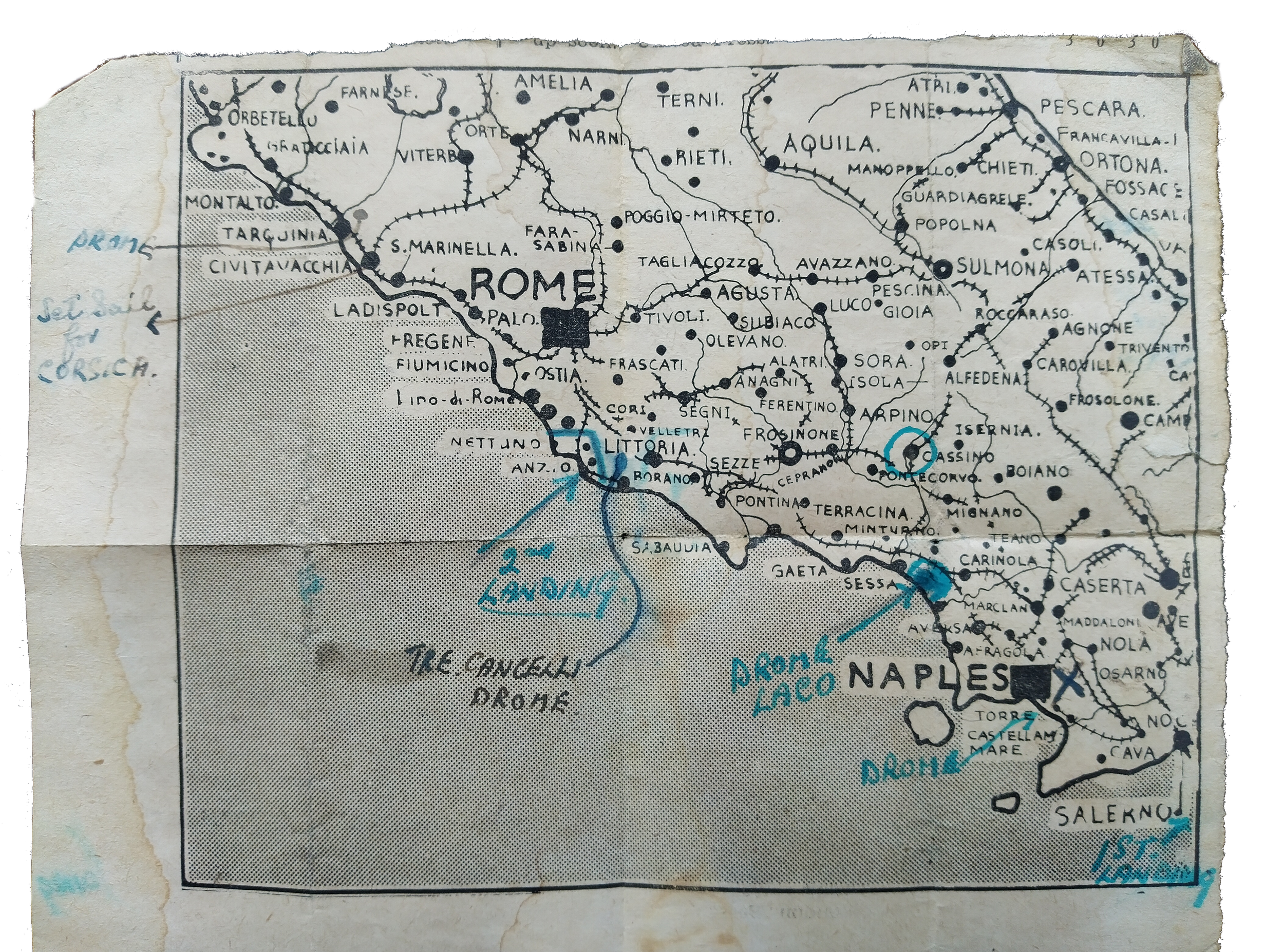
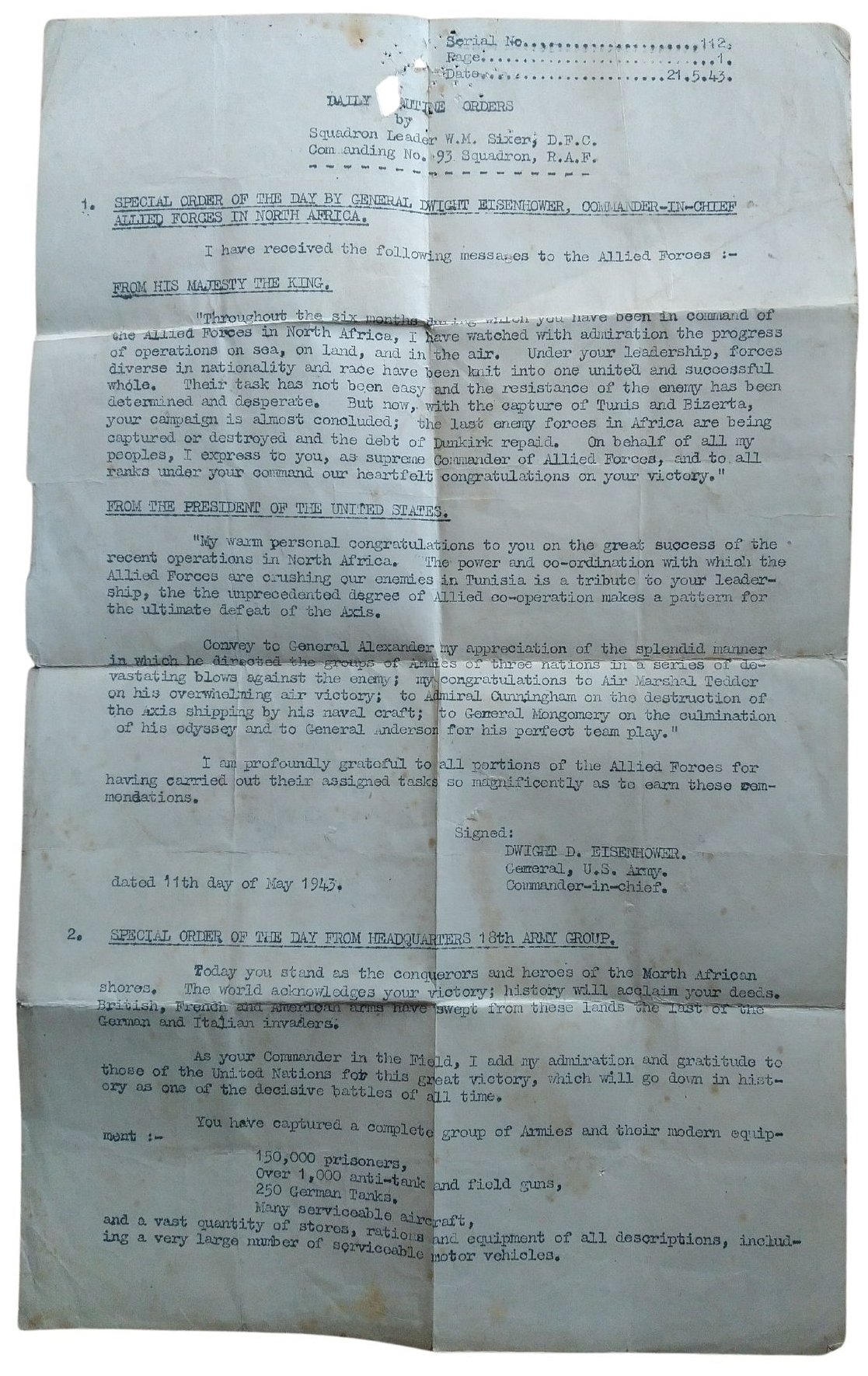
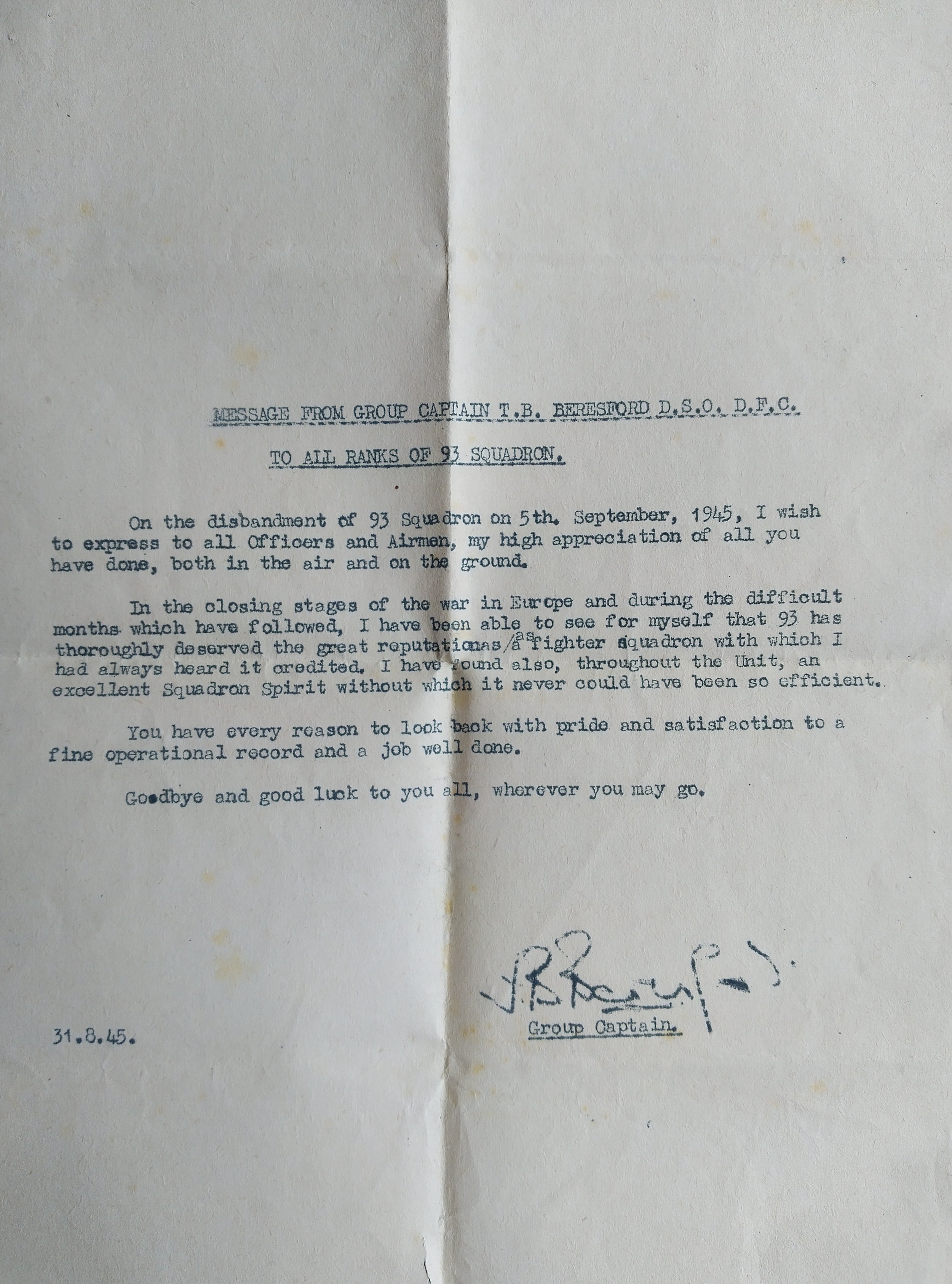
Sources:
The personal papers and diaries of Dick Hewitt, No. 93 Squadron, RAF.
Books
Evans, Bryn, The Decisive Campaigns of the Desert Air Force 1942-1945 (Pen & Sword, 2014), eBook.
Farish, Greggs, McCaul, Michael, Algiers to Anzio with 72 & 111 Squadrons (Woodfield Publishing, 2002).
Rawlings, John, Fighter Squadrons of the R.A.F. and Their Aircraft (Crecy Publishing, 1992).
Websites
1. https://www.bbc.co.uk/history/ww2peopleswar/stories/01/a2055601.shtml
3. https://www.iwm.org.uk/history/operation-husky
4. https://www.iwm.org.uk/history/anzio-the-invasion-that-almost-failed
5. https://wikisummaries.org/operation-dragoon/
6. https://www.jeversteamlaundry.org/93squadhistory2.htm
7. https://www.keymilitary.com/article/prejudice-good-order
8. http://www.rafcommands.com/database/serials/details.php?uniq=MH324
4 Reasons to Research Your Ancestor's Military Service History
In this blog post, we'll explore why researching an ancestor's military service history can be of great benefit to individuals and families.
Genealogy, or the study of family history and ancestry, has become increasingly popular in recent years. It allows individuals to discover their roots, learn about their ancestors' lives, and connect with their heritage. One aspect of genealogy that can be particularly fascinating is researching an ancestor's military service history.
In this blog post, we'll explore why researching an ancestor's military service history can be of great benefit to individuals and families.
1. Gaining a deeper understanding of your family history
One of the main benefits of researching an ancestor's military service history is that it allows individuals to gain a deeper understanding of their family history. Military service records can provide details on an ancestor's rank, service dates, and where they served. This information can help individuals develop a clearer picture of their ancestor's life and experiences. For example, The National Archives provides access to military service records for British Army soldiers who served between 1914 and 1920. By examining these records, individuals can discover where their ancestors served, what battles they may have fought in, and even details about their injuries or medals awarded.
2. Connecting with national heritage
Researching an ancestor's military service history can also help individuals connect with their national heritage. In the UK, military service has played a significant role in shaping the country's history and identity. By researching an ancestor's military service, individuals can gain a better understanding of the contributions made by their family members to the country's military efforts. This can help individuals develop a stronger sense of connection to their country and its history. For example, the Imperial War Museum (IWM) in London has a collection of over 1 million items that tell the story of modern war and conflict, from personal accounts of soldiers who served in the British Army to numerous films, photographs, and publications. These documents can provide a first-hand look at what life was like for soldiers on the front lines, and help individuals connect with their ancestor's experiences.
3. Discovering previously unknown information
Researching an ancestor's military service history can also uncover previously unknown information about their life and experiences. Military service records may provide details about an ancestor's family, occupation, and other aspects of their life that were not previously known. For example, The National Archives notes that military service records can include details about an individual's next of kin, address, and occupation before and after their military service. By discovering this information, individuals can develop a more complete picture of their ancestor's life.
4. Honouring an ancestor's military service
Researching an ancestor's military service history can also be a way to honour their service and sacrifice. By uncovering the details of an ancestor's military service, individuals can gain a deeper appreciation for the challenges they faced and the contributions they made. This can be especially meaningful for individuals whose ancestors were killed in action or suffered injuries during their service. For example, the Commonwealth War Graves Commission (CWGC) maintains records of individuals who died in military service during both World Wars. By researching these records, individuals can pay tribute to their ancestors who made the ultimate sacrifice for their country.
In conclusion, researching an ancestor's military service history can be a valuable and rewarding aspect of genealogy. By gaining a deeper understanding of family history, connecting with national heritage, discovering previously unknown information, and honouring an ancestor's service, individuals can develop a stronger sense of connection to their past and their family's contributions to history. The UK is home to a wealth of resources for researching military service history, including the National Archives, the Imperial War Museum, and the Commonwealth War Graves Commission. By utilizing these resources, individuals can unlock the fascinating and often poignant stories of their ancestors' military service.
If you want to know more about your ancestors' military service, please contact me today.

